As a parent, you might wonder if your preschooler is ready to start writing. Knowing if your child is ready for writing is key for their future in school. You want to make sure they have the skills to do well in writing. But how do you know when it’s the right time to begin?
It’s important to understand the skills your child needs to develop. Writing readiness in preschoolers involves physical, cognitive, and fine motor skills. Recognizing these skills helps you support your child in becoming a confident writer.
Remember, every child learns at their own pace. Knowing the important milestones and skills for writing helps you create a supportive environment. This environment encourages your child to grow and develop their writing skills.
Key Takeaways
- Determining preschooler writing readiness is key for future success
- Physical, cognitive, and fine motor skills are vital for writing
- Knowing the key skills helps you support your child
- Every child learns at their own pace, so patience is important
- A nurturing environment fosters growth and encourages writing
- Understanding milestones helps support your child’s writing journey
Understanding Writing Readiness in Preschoolers
As a parent, you want the best for your child, including their writing skills. Writing readiness is key to their development. It’s important to know what it means and how to support it. Your child will make great progress in writing as they grow.
Timing is everything in writing readiness. You want your child to start writing when they’re ready. This makes learning fun and easy for them. Knowing the milestones helps you support your child’s writing journey.
What is Writing Readiness?
Writing readiness means your child is ready to start writing. They need fine motor skills, hand-eye coordination, and thinking abilities. You can help by giving them chances to practice these skills.
Why Timing Matters
Timing is key in writing readiness. Starting too early can make your child frustrated. But, starting when they’re ready helps them enjoy writing and build a strong foundation.
The Development Timeline
Children develop at their own pace, but there are milestones for writing. These include:
- Showing an interest in writing and drawing
- Developing the necessary fine motor skills to hold a pencil
- Making marks on paper and attempting to write
- Developing hand-eye coordination and cognitive abilities
Knowing these milestones helps you support your child’s writing. This sets them up for success in the future.
Physical Signs Your Child is Ready to Write
As a parent, you might wonder if your child is ready to start writing. Look for physical signs to see if they’re ready. These signs include hand dominance, finger strength, and dexterity. Recognizing these signs helps you know if your child is ready to start learning to write.
Some key physical signs to look out for include:
- Hand dominance: Is your child showing a preference for using one hand over the other?
- Finger strength: Can your child grasp and manipulate small objects with ease?
- Dexterity: Is your child able to move their fingers and hands with precision and control?
These signs are important to check if a child is ready to write. By watching your child’s physical growth and looking for these signs, you can see if they’re ready to start writing.
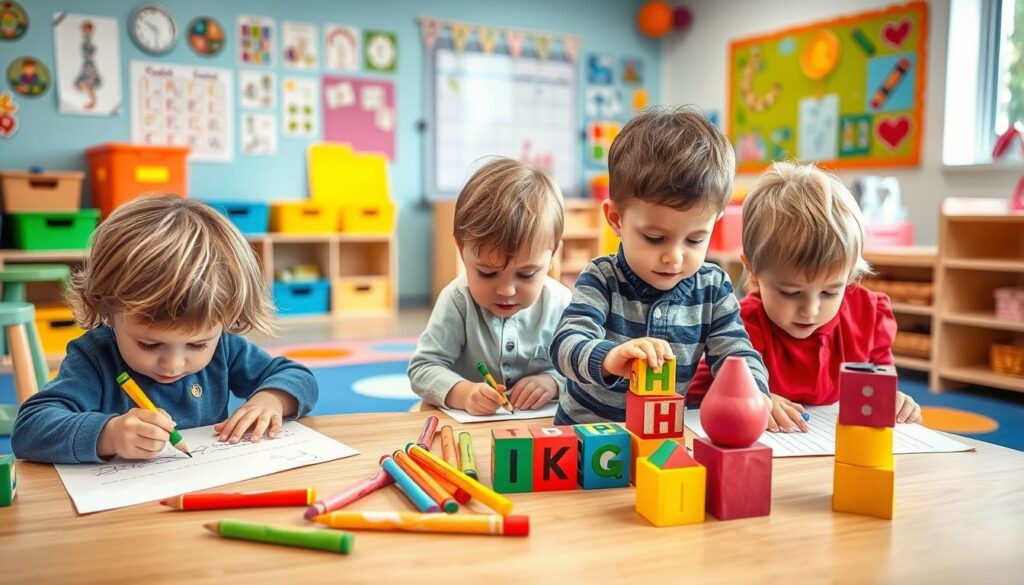
You can also help your child’s physical development. Give them chances to do activities that improve hand-eye coordination, finger strength, and dexterity. This can be playdough, puzzles, or other activities that help with fine motor skills. This way, you help your child get the physical skills they need for writing and other school subjects.
| Physical Sign | Description |
|---|---|
| Hand Dominance | Preference for using one hand over the other |
| Finger Strength | Ability to grasp and manipulate small objects |
| Dexterity | Precision and control in finger and hand movements |
Essential Fine Motor Skills for Writing Success
When you see your child showing signs of wanting to write, it’s key to check their fine motor skills. These skills involve using small muscles in the hands and fingers. Look to see if they can hold a pencil or crayon well, but not too hard.
Grip and Grasp Development
A good grip and grasp are key for writing. Give your child different things to hold and play with. This could be playdough, puzzles, or small toys.
Hand-Eye Coordination
Hand-eye coordination is also important for writing. Engage your child in activities that need coordination. This could be catching a ball, playing with a balloon, or using tweezers.
Finger Strength and Dexterity
Finger strength and dexterity are also needed for writing. Give your child activities that make them move their fingers. This could be playing the piano, using a keyboard, or playing with playdough.
By understanding the role of fine motor skills in writing, you can help your child. Give them chances to practice these skills. This will make them more confident and skilled in writing, showing they’re ready to write.
Cognitive Milestones That Signal Writing Readiness
When getting preschoolers ready to write, it’s key to know the signs they’re ready. They should understand symbols, recognize letters, and solve problems. These are important steps to see if a child is ready to start writing.
Look for symbol recognition as a sign they grasp that symbols and letters mean something. This is a big step towards reading and writing. You can help by doing puzzles, games, and reading together with your child.
Problem-solving skills are also vital. As they learn to think and solve problems, they’ll feel more confident in writing. Give them puzzles, brain teasers, and open-ended questions to help.
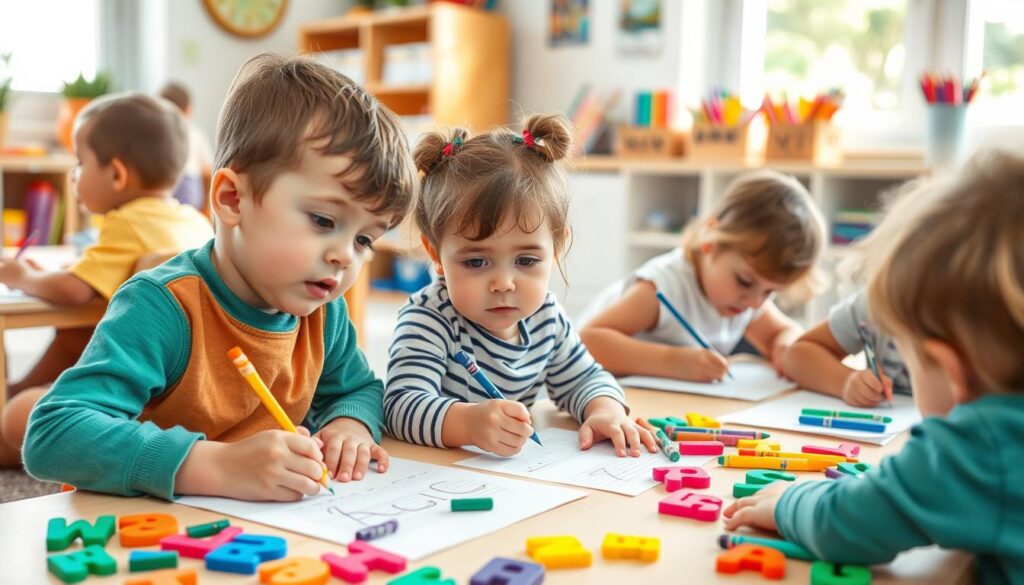
By spotting these signs, you can help your child grow in writing. Create a supportive space and encourage them with activities that help them get ready to write. With time, effort, and the right support, your child will become a skilled writer.
The Role of Drawing in Writing Development
As you watch your child grow, you might ask, is my preschooler ready to learn to write? Drawing is key in their writing journey. It boosts skills like recognizing symbols, hand-eye coordination, and fine motor control.
At first, your child’s drawings are scribbles. But soon, they turn into shapes. This is a big step in their writing journey. It helps them grasp symbols and letters. You can help by giving them crayons, markers, and paper.
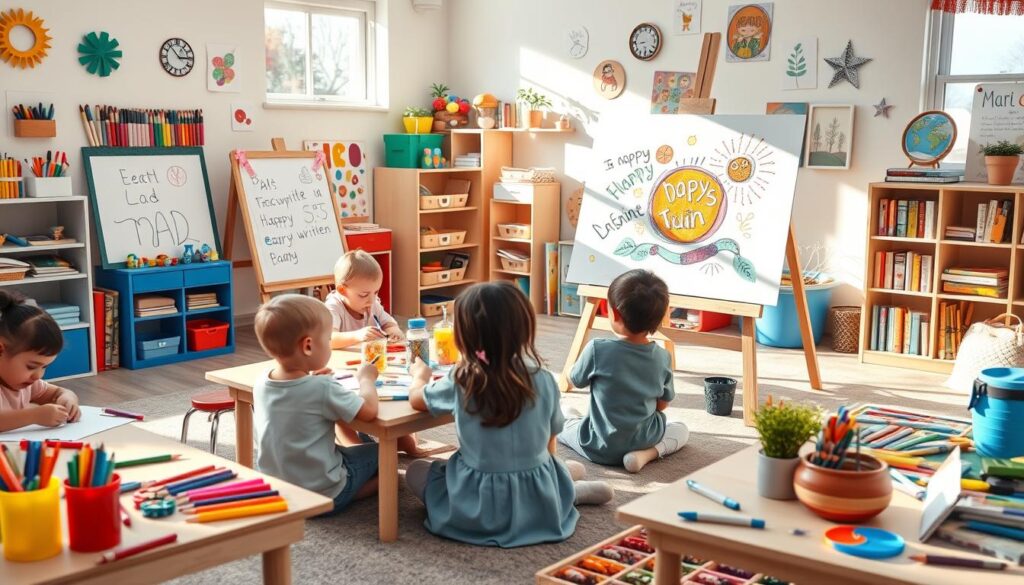
From Scribbles to Shapes
This change is a big deal in your child’s writing growth. Moving from scribbles to shapes shows they’re learning about symbols. Symbols are important for writing.
Understanding Symbol Recognition
Recognizing symbols is vital for writing. When your child gets symbols, they start linking them to sounds and letters. This is a big step towards writing.
Picture-to-Letter Transition
As your child gets better at drawing, they connect pictures to letters. This is a big step in their writing journey. It shows them letters and words can represent things and ideas.
Is My Preschooler Ready to Learn to Write? Key Signs to Look For
As a parent, you want to make sure your child is ready for the next step in school. Checking if your child is ready to write is important. Their ability to show preschooler writing skills tells you if they’re ready to start writing.
Some key signs to look for include:
- Physical signs, such as proper grip and posture
- Fine motor skills, including hand-eye coordination and finger dexterity
- Cognitive development, such as understanding symbols and shapes
By noticing these signs, you can decide if your child is ready to write. This helps you support their preschooler writing skills development.
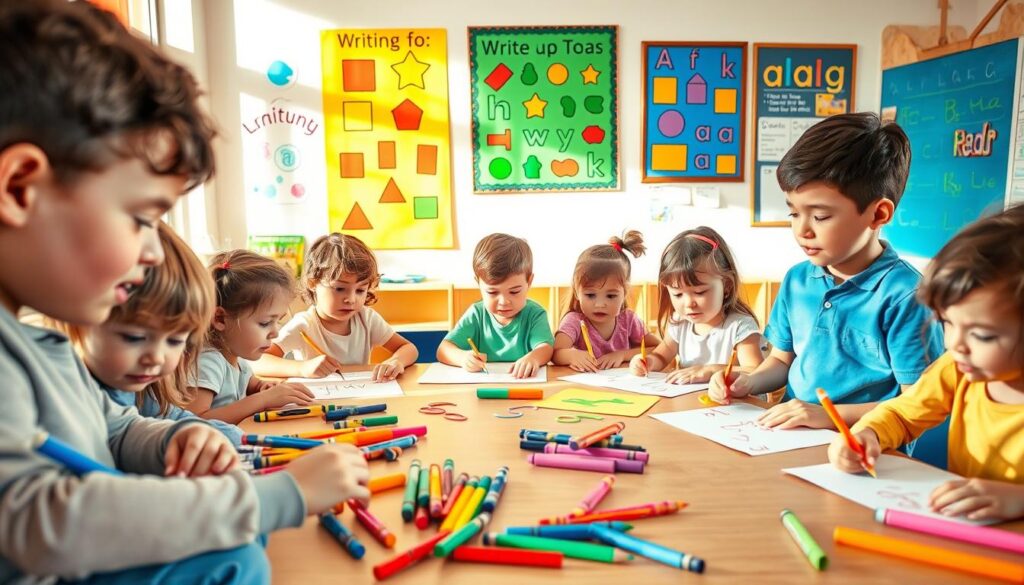
Remember, every child learns at their own pace. Some might need more time to get good at writing. Being patient and supportive helps your child build a strong base for school success.
| Signs of Readiness | Description |
|---|---|
| Physical Signs | Proper grip and posture |
| Fine Motor Skills | Hand-eye coordination and finger dexterity |
| Cognitive Development | Understanding symbols and shapes |
Creating a Writing-Friendly Environment at Home
To help your child write better, make your home a great place for writing. You need the right tools, a special writing area, and daily practice. This will help your child reach important developmental milestones for writing and get ready to write.
A good writing area is key. Set up a desk or table with good light, a comfy chair, and the basics like paper and pencils.
Essential Materials and Tools
- Paper and notebooks
- Pencils, crayons, and markers
- Eraser and sharpener
- Writing guides and templates
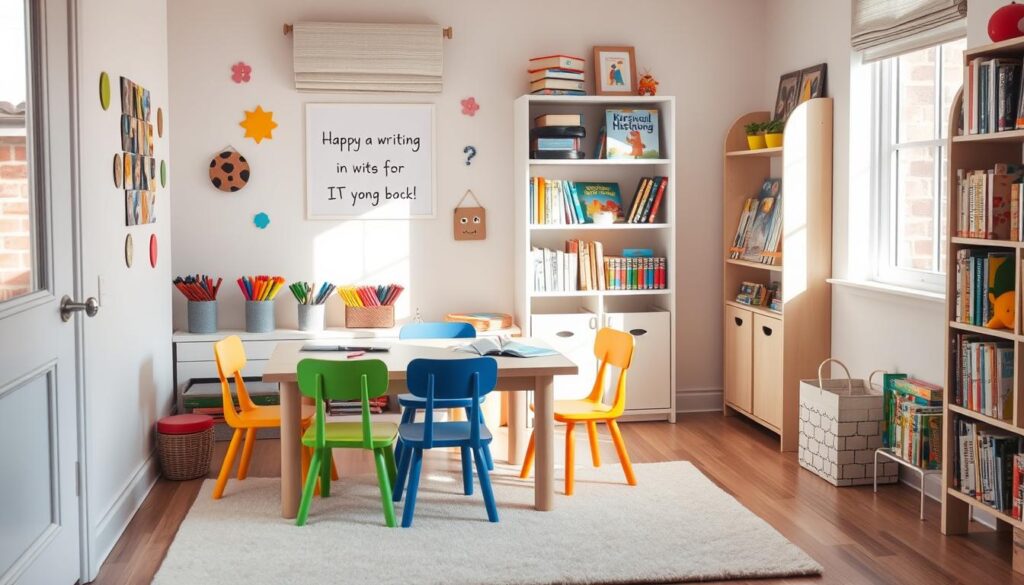
Setting Up a Writing Space
Think about what your child likes when setting up their writing area. It should be comfy, well-lit, and free from distractions. Adding fun quotes or prompts can make it more exciting.
| Writing Space Essentials | Description |
|---|---|
| Desk or table | A sturdy and comfortable surface for writing |
| Good lighting | Natural or artificial light that reduces eye strain |
| Comfortable chair | A chair that provides adequate support and comfort |
Daily Opportunities for Practice
Give your child chances to practice writing every day. They can write in a journal, draw, or just practice writing their name. Make it fun and always praise their efforts.
Pre-Writing Activities That Build Essential Skills
As a parent, you are key in helping your child develop pre-writing skills for preschoolers. Doing various activities can help your child get better at fine motor skills, hand-eye coordination, and thinking. These skills are important signs of writing readiness and prepare your child for writing.
Activities like tracing, coloring, and playdough can improve your child’s fine motor skills and hand-eye coordination. Puzzles, matching games, and sorting objects can also boost their thinking abilities.
Here are some benefits of pre-writing activities:
- Develop fine motor skills and hand-eye coordination
- Improve cognitive abilities, such as problem-solving and critical thinking
- Enhance creativity and self-expression
- Build confidence and prepare your child for writing
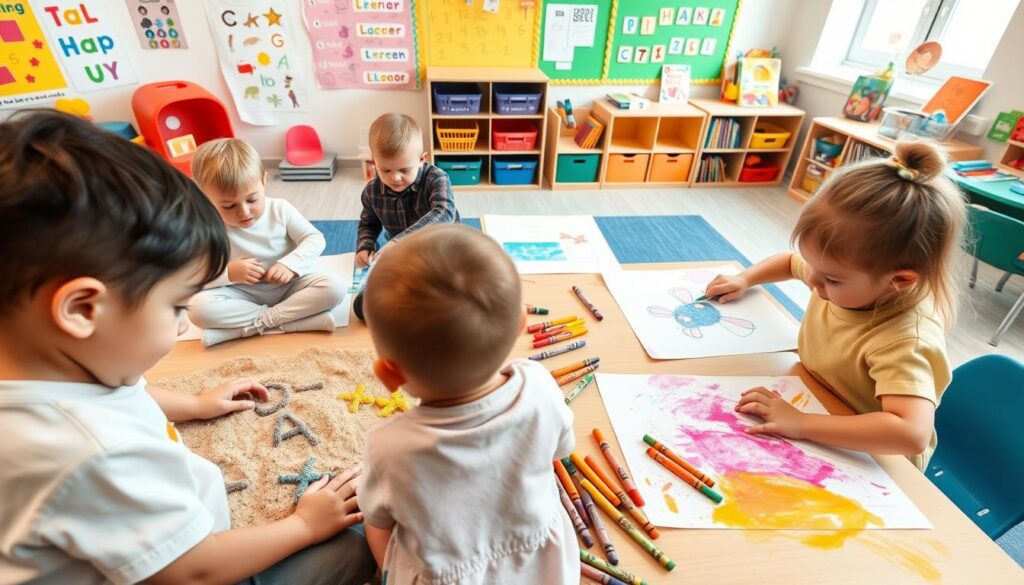
By doing these pre-writing activities, you help your child get ready for writing. Make sure these activities are fun and engaging. Also, offer support and encouragement as your child grows their pre-writing skills for preschoolers and shows signs of writing readiness.
| Activity | Benefits |
|---|---|
| Tracing | Develops fine motor skills and hand-eye coordination |
| Coloring | Enhances creativity and self-expression |
| Playdough | Develops fine motor skills and hand-eye coordination |
Common Challenges and How to Address Them
When getting preschoolers ready for writing, knowing common challenges is key. Fine motor skills for writing are vital, and some kids might face grip issues, resistance to writing, or developmental delays. Understanding these issues helps you support your child effectively.
For grip problems, try using bigger grips or tools that adapt to their needs. Make writing fun with games and activities that boost their skills. If you think there might be developmental delays, talk to their teacher or a healthcare expert.
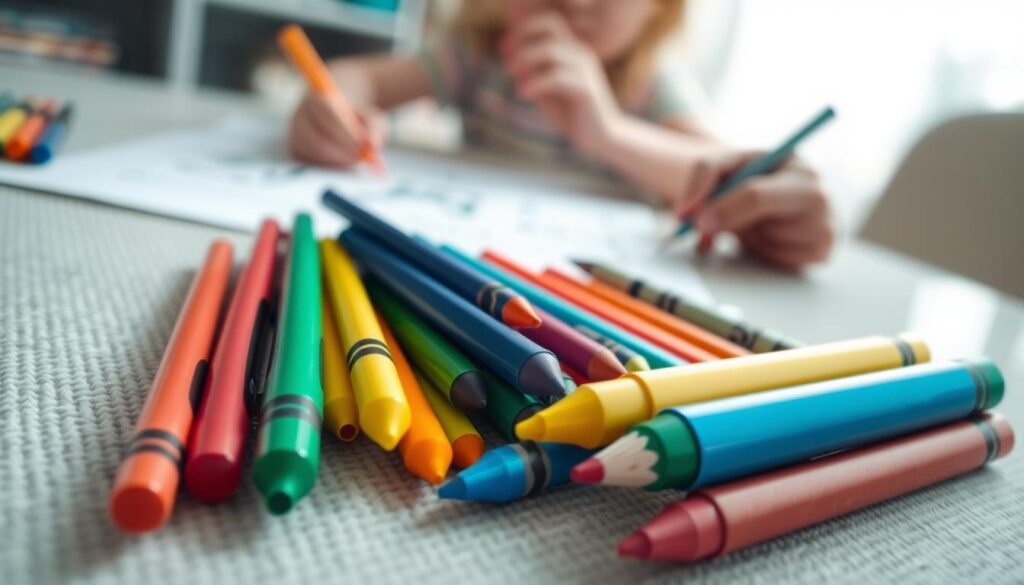
- Providing a variety of writing tools and materials to experiment with
- Encouraging your child to draw and create art to develop their fine motor skills
- Breaking writing tasks into smaller, manageable steps to build confidence
Being patient, supportive, and proactive can help your child overcome these challenges. Every child learns at their own pace. With the right approach, your child can excel in writing.
Working With Your Child’s Natural Development Pace
Every child grows at their own speed. When it comes to writing, it’s key to respect their pace. Wondering is my preschooler ready to learn to write? It’s all about knowing their unique growth path.
Avoiding Pressure
Too much pressure on your child can be bad. It might make them feel stressed. Instead, create a space where they can learn naturally. Offer play-based activities that help with fine motor skills and hand-eye coordination.
Celebrating Progress
It’s important to celebrate small wins with your child. This boosts their confidence and keeps them motivated. Here are some ways to do it:
- Displaying their artwork and writing samples
- Providing positive feedback and encouragement
- Engaging in activities that promote a sense of accomplishment
By supporting your child’s natural pace and avoiding pressure, you help them build a strong writing foundation. And you encourage a lifelong love of learning.
| Age | Developmental Milestone |
|---|---|
| 3-4 years | Shows interest in writing and drawing |
| 4-5 years | Develops fine motor skills and hand-eye coordination |
| 5-6 years | Begins to demonstrate an understanding of writing concepts |
When to Seek Professional Guidance
As a parent, you are key in helping your child get ready to write. You also help them improve their writing skills. Sometimes, your child might need extra help to overcome writing challenges. It’s important to know when they need help from a professional.
Signs your child might need help include trouble with fine motor skills or not knowing letters. If they seem uninterested in writing, it’s time to get professional help. A qualified person, like an occupational therapist or special education teacher, can be very helpful.
Getting professional help ensures your child gets the support they need. A professional can find out why your child is struggling and offer specific solutions. They might suggest activities to improve fine motor skills or games to help with letter recognition.
Every child learns at their own pace. Some need more help than others. By getting professional help when needed, you can help your child develop strong writing skills. This will prepare them for success in school and beyond.
Seeking professional guidance has many benefits. Here are a few:
- Personalized support tailored to your child’s unique needs
- Expert guidance on how to overcome specific challenges
- Access to specialized resources and activities
- Enhanced collaboration between you, your child, and the professional
Conclusion: Supporting Your Child’s Writing Journey
Every child grows at their own speed when it comes to writing. By creating a supportive and nurturing space, you can help your preschooler grow into a confident writer. Celebrate their developmental milestones for writing and stay in touch with their writing readiness in young children.
If you have any worries, don’t hesitate to ask for help from teachers or experts. With patience, hard work, and a bit of creativity, you can make writing a fun and rewarding journey for your child.
